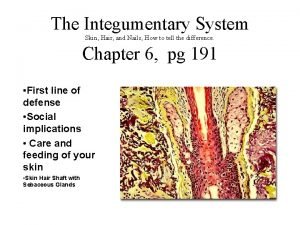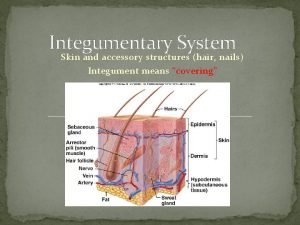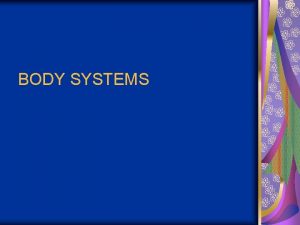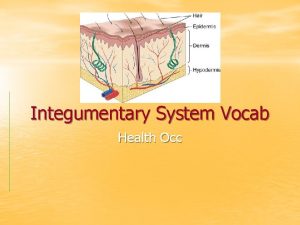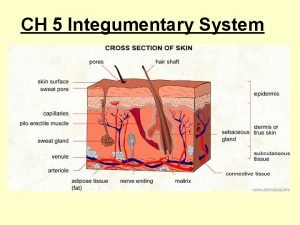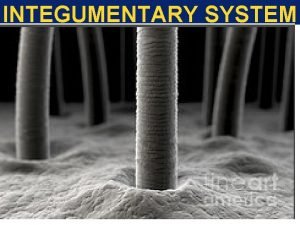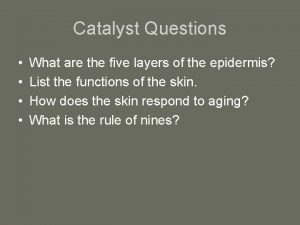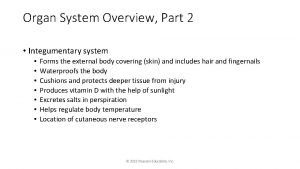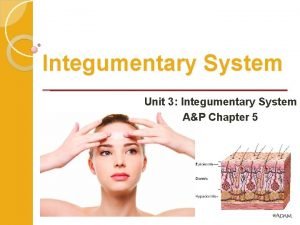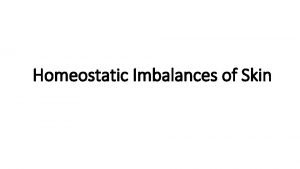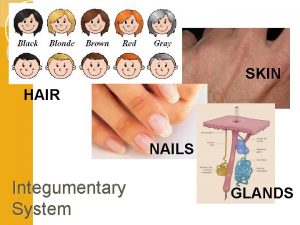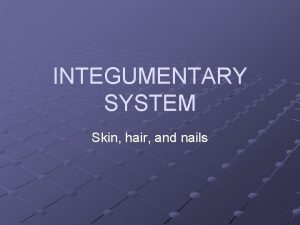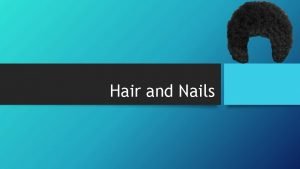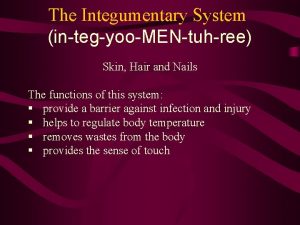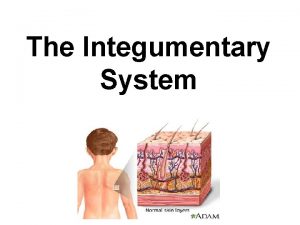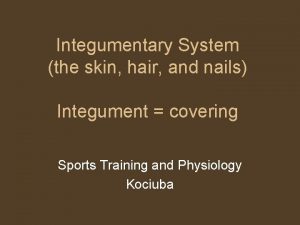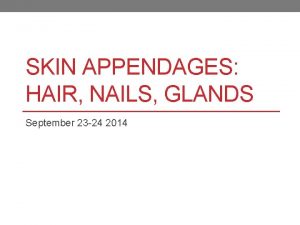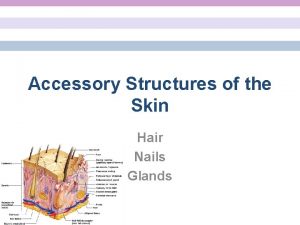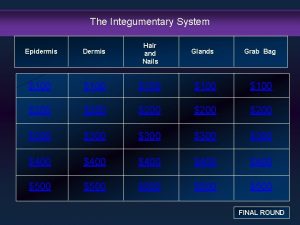The Integumentary System Skin Hair Glands Nails The






























- Slides: 30

The Integumentary System Skin, Hair, Glands, & Nails

The Skin � Cutaneous membrane ◦ Waterproof, stretchable, and invisibly repairs cuts, rips, or burns � Functions ◦ ◦ ◦ ◦ Protection Maintains body temperature Prevents excessive loss of inorganic & organic materials Receives stimuli Stores chemical compounds Synthesizes vitamin D Excretes water, salts, & several organic compounds

Structure of the Skin �Composed of two layers of tissue ◦ Epidermis �Outer layer composed of squamous epithelium ◦ Dermis �Underlying layer composed of dense connective tissue �The epidermis & dermis are fully cemented together �Skin is anchored to the underlying organs by the subcutaneous layer (Adipose Tissue) ◦ Acts as a shock absorber & insulation


The Epidermis �Epidermis ◦ ◦ ◦ Layers from deepest to the surface Stratum Basale (Germinativum) Stratum Spinosum Stratum Granulosum Stratum Lucidum Stratum Corneum � The germinativum & spinosum undergo continual cell division & produce all the other layers � As cells move toward the surface, they become flatter, increasingly full of keratin (harden) & finally die ◦ Can no longer get adequate nutrients & oxygen from the dermis


The Dermis �Two major regions: ◦ Papillary Area �Upper dermal region �Contains finger-like projections (dermal papillae) that indent the epidermis above �Dermal papillae bring nutrients to the epidermis ◦ Reticular Area – deepest skin layer �Contains blood vessels, sweat & oil glands, & deep pressure sensors �Contains collagen & elastic fibers �Varies in thickness depending on the locations on the body



Skin Color �Determined by 3 pigments ◦ Melanin �Brown & black pigment �Found in the epidermis �Produced by melanocytes �Acts as protection from UV rays ◦ Carotene �Orange-yellow pigment ◦ Hemoglobin �Blood in the capillaries of the dermis �Pigment in red blood cells – “rosy” skin tone

Alteration of Skin Color �Blue Color ◦ Indicates cyanosis: poor oxygenation ◦ Heart failure & severe breathing �Redness or Erythema ◦ Indicates embarrassment, fever, hypertension, inflammation, or allergy �Pallor or blanching ◦ Indicates fear, anger, or emotional stress ◦ Also anemia, low blood pressure, or impaired blood flow �Jaundice or a yellow cast ◦ Signifies a liver disorder due to excess bile

Skin Appendages These appendages come from the epidermis and help maintain the body’s homeostasis. � Cutaneous (relating to skin) glands ◦ Sebaceous glands ◦ Sweat glands � Hair follicles � Nails

Appendages of the Skin �Sebaceous glands ◦ Produce oil � Lubricant for skin which keeps skin soft and moist � Prevents brittle hair � Kills bacteria (slightly acidic) ◦ Most have ducts that empty into hair follicles; others open directly onto skin surface ◦ Glands are activated at puberty and this is what causes teenage acne

Appendages of the Skin

Facial Blemishes �Whitehead – sebaceous gland is blocked usually from the oily substance made by the gland. �Blackhead – when whitehead dries, it darkens forming blackhead �Acne – an active infection of the sebaceous glands caused by bacteria

Appendages of the Skin �Sweat glands ◦ Produce sweat ◦ Widely distributed in skin �(2. 5 million person) ◦ helps cool the body ◦ Two types � Eccrine � Open via duct to pore on skin surface � Most numerous on the body � Apocrine � Ducts empty into hair follicles � Found mostly in armpits and genital areas � Precise function is unknown but are they are activated during pain, stress and during sexual foreplay.

Appendages of the Skin

Sweat and Its Function �Composition ◦ Mostly water ◦ Salts and vitamin C ◦ Some metabolic waste (urea and uric acid) ◦ Fatty acids and proteins (apocrine only) �Function ◦ Helps rid body of excess heat ◦ Excretes waste products ◦ Acidic nature inhibits bacteria growth �Odor is from associated bacteria

Appendages of the Skin �Hair ◦ Produced by hair follicle which are made of hard keratinized epithelial cells ◦ Melanocytes provide pigment for hair color

Structure of Hair Follicle

Hair Anatomy �Hair anatomy ◦ Central medulla ◦ Cortex surrounds medulla ◦ Cuticle on outside of cortex � Most heavily keratinized

Hair Structures �Associated hair structures ◦ Hair follicle � Dermal and epidermal sheath surround hair root ◦ Arrector pili muscle � Smooth muscle � Pulls hairs upright when cold or frightened ◦ Sebaceous gland

Nails � Nails ◦ Scale-like modifications of the epidermis �Heavily keratinized ◦ Stratum basale extends beneath the nail bed �Responsible for growth ◦ Lack of pigment makes them colorless

Nail Anatomy �Nail structures ◦ Free edge ◦ Body is the visible attached portion ◦ Root of nail embedded in skin ◦ Cuticle is the proximal nail fold that projects onto the nail body

Severity of Burns �First-degree burns ◦ Only epidermis is damaged ◦ Skin is red and swollen �Second-degree burns ◦ Epidermis and upper dermis are damaged ◦ Skin is red with blisters �Third-degree burns (worst) ◦ Destroys entire skin layer ◦ Burn is gray-white or black

Severity of Burns

Rule of Nines �Way to determine the extent of burns �Body is divided into 11 areas for quick estimation �Each area represents about 9% of total body surface area

Skin Cancer Types �Basal cell carcinoma ◦ Malignant tumor of the basal cell layer of the epidermis �Squamous cell carcinoma ◦ Metastasizes to lymph nodes if not removed ◦ Early removal allows a good chance of cure ◦ Believed to be sun-induced ◦ Arises from stratum spinosum

Skin Cancer Types

Skin Cancer Types �Malignant melanoma ◦ Cancerous growth composed of melanocytes
 Skin hair and nails system
Skin hair and nails system Nails integumentary system
Nails integumentary system Nails assessment
Nails assessment Glands in integumentary system
Glands in integumentary system Mucous acini
Mucous acini Hair and fingernails continue to grow after death
Hair and fingernails continue to grow after death Skin is the largest organ
Skin is the largest organ Thin skin vs thick skin
Thin skin vs thick skin Chapter 23 milady review questions
Chapter 23 milady review questions Nails body system
Nails body system Integumentary system vocabulary
Integumentary system vocabulary Fetal pig integumentary system
Fetal pig integumentary system Pengertian sistem integumen
Pengertian sistem integumen Epidermis layers
Epidermis layers Exercise 7 the integumentary system
Exercise 7 the integumentary system Integumentary system abbreviations
Integumentary system abbreviations Exfoliative dermatitis
Exfoliative dermatitis The integumentary system
The integumentary system Integumentary system physical examination
Integumentary system physical examination Excretory system analogy
Excretory system analogy Cat integumentary system
Cat integumentary system The integumentary system
The integumentary system Integumentary system components
Integumentary system components Effects of aging on the integumentary system
Effects of aging on the integumentary system Section 36-3 the integumentary system
Section 36-3 the integumentary system Integumentary system
Integumentary system Integumentary system
Integumentary system Unit 3 integumentary system
Unit 3 integumentary system Homeostatic imbalances of the integumentary system
Homeostatic imbalances of the integumentary system Dermal structure
Dermal structure 6 functions of the integumentary system
6 functions of the integumentary system
